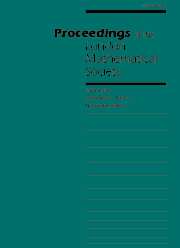Crossref Citations
This article has been cited by the following publications. This list is generated based on data provided by
Crossref.
Rourke, Colin
and
Sanderson, Brian
2001.
The compression theorem I.
Geometry & Topology,
Vol. 5,
Issue. 1,
p.
399.
Carter, J Scott
Elhamdadi, Mohamed
and
Saito, Masahico
2002.
Twisted quandle homology theory and cocycle knot invariants.
Algebraic & Geometric Topology,
Vol. 2,
Issue. 1,
p.
95.
Kamada, Seiichi
2002.
Knot invariants derived from quandles and racks.
p.
103.
Matveev, Sergei
and
Polyak, Michael
2002.
Cubic complexes and finite type invariants.
p.
215.
Rourke, Colin
and
Sanderson, Brian
2003.
The compression theorem III: applications.
Algebraic & Geometric Topology,
Vol. 3,
Issue. 2,
p.
857.
Ohtsuki, Tomotada
2004.
Problems on invariants of knots and 3–manifolds.
p.
377.
TANAKA, KOKORO
2005.
ON SURFACE-LINKS REPRESENTED BY DIAGRAMS WITH TWO OR THREE TRIPLE POINTS.
Journal of Knot Theory and Its Ramifications,
Vol. 14,
Issue. 08,
p.
963.
Tanaka, Kokoro
2007.
Inequivalent surface-knots with the same knot quandle.
Topology and its Applications,
Vol. 154,
Issue. 15,
p.
2757.
RUBINSZTEIN, RYSZARD L.
2007.
TOPOLOGICAL QUANDLES AND INVARIANTS OF LINKS.
Journal of Knot Theory and Its Ramifications,
Vol. 16,
Issue. 06,
p.
789.
Iwakiri, Masahide
2009.
The lower bound of the 𝑤-indices of surface links via quandle cocycle invariants.
Transactions of the American Mathematical Society,
Vol. 362,
Issue. 3,
p.
1189.
AMEUR, KHEIRA
and
SAITO, MASAHICO
2009.
POLYNOMIAL COCYCLES OF ALEXANDER QUANDLES AND APPLICATIONS.
Journal of Knot Theory and Its Ramifications,
Vol. 18,
Issue. 02,
p.
151.
Nosaka, Takefumi
2011.
On homotopy groups of quandle spaces and the quandle homotopy invariant of links.
Topology and its Applications,
Vol. 158,
Issue. 8,
p.
996.
CLAUWENS, FRANS
2011.
THE ALGEBRA OF RACK AND QUANDLE COHOMOLOGY.
Journal of Knot Theory and Its Ramifications,
Vol. 20,
Issue. 11,
p.
1487.
Nosaka, Takefumi
2011.
4–fold symmetric quandle invariants of 3–manifolds.
Algebraic & Geometric Topology,
Vol. 11,
Issue. 3,
p.
1601.
VENDRAMIN, L.
2012.
ON THE CLASSIFICATION OF QUANDLES OF LOW ORDER.
Journal of Knot Theory and Its Ramifications,
Vol. 21,
Issue. 09,
p.
1250088.
FENN, ROGER
2012.
TACKLING THE TREFOILS.
Journal of Knot Theory and Its Ramifications,
Vol. 21,
Issue. 13,
p.
1240004.
Elhamdadi, Mohamed
and
Nelson, Sam
2012.
$N$-degeneracy in rack homology and link invariants.
Hiroshima Mathematical Journal,
Vol. 42,
Issue. 1,
Przytycki, Józef H.
and
Putyra, Krzysztof K.
2013.
Homology of distributive lattices.
Journal of Homotopy and Related Structures,
Vol. 8,
Issue. 1,
p.
35.
Przytycki, Józef H.
and
Sikora, Adam S.
2014.
Distributive Products and Their Homology.
Communications in Algebra,
Vol. 42,
Issue. 3,
p.
1258.
Dehornoy, Patrick
and
Lebed, Victoria
2014.
Two- and three-cocycles for Laver tables.
Journal of Knot Theory and Its Ramifications,
Vol. 23,
Issue. 04,
p.
1450017.


